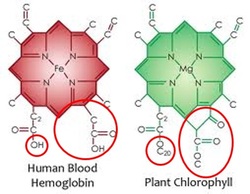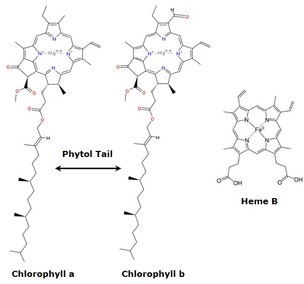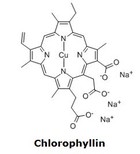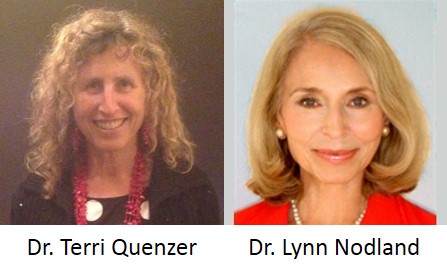I absolutely LOVE my green smoothies! Which got me thinking about chlorophyll, since chlorophyll is what makes my green smoothies, well, green. Of course, that and the fact that I actually put those green veggies into my smoothies. Maybe you remember that you learned something about chlorophyll back when you were in school.
Let’s revisit chlorophyll and look at the benefits and clarify the myths. There’s so much information about chlorophyll that I’m going to break it into two parts. In Part 1 (this post) I will tell you a little about the chemistry of chlorophyll and its similarities (and differences) to hemoglobin in blood in order to lay the foundation for deciphering the benefits from the myths, which I will present in Part 2.
Chlorophyll, a phytochemical, is the molecule in plants and algae that make them green. Chlorophyll is also the molecule that is responsible for photosynthesis in plants. Energy absorbed by chlorophyll in the form of sunlight converts carbon dioxide and water into glucose and oxygen:
Let’s revisit chlorophyll and look at the benefits and clarify the myths. There’s so much information about chlorophyll that I’m going to break it into two parts. In Part 1 (this post) I will tell you a little about the chemistry of chlorophyll and its similarities (and differences) to hemoglobin in blood in order to lay the foundation for deciphering the benefits from the myths, which I will present in Part 2.
Chlorophyll, a phytochemical, is the molecule in plants and algae that make them green. Chlorophyll is also the molecule that is responsible for photosynthesis in plants. Energy absorbed by chlorophyll in the form of sunlight converts carbon dioxide and water into glucose and oxygen:
Glucose is a sugar, a simple carbohydrate that serves as a building block for plants to make other simple sugars as well as complex carbohydrates (starch and fiber). Glucose also happens to make up the majority our blood sugar and is the primary source of fuel in our bodies when burned by the oxygen that we breathe in.
Chlorophyll is considered the “blood of plants” because of similarities between chlorophyll molecules (chlorophyll a and b specifically found in plants) and the heme subunit of hemoglobin molecules in blood. Both chlorophyll and heme molecules have similar (but not identical) chemical structures, ring structures (porphyrin rings) that contain a charged metal atom (ion) in the center of the ring. Chlorophyll contains magnesium, which makes plants green and heme contains iron, which makes blood red. Chlorophyll and hemoglobin both transport and release oxygen. Chlorophyll releases oxygen to the air and hemoglobin releases oxygen to our cells.
Chlorophyll is considered the “blood of plants” because of similarities between chlorophyll molecules (chlorophyll a and b specifically found in plants) and the heme subunit of hemoglobin molecules in blood. Both chlorophyll and heme molecules have similar (but not identical) chemical structures, ring structures (porphyrin rings) that contain a charged metal atom (ion) in the center of the ring. Chlorophyll contains magnesium, which makes plants green and heme contains iron, which makes blood red. Chlorophyll and hemoglobin both transport and release oxygen. Chlorophyll releases oxygen to the air and hemoglobin releases oxygen to our cells.
There is an interesting relationship between chlorophyll, hemoglobin, oxygen, carbon dioxide, plants, and animals. Chlorophyll in plants absorbs carbon dioxide out of the air for photosynthesis and produces oxygen as waste that gets released back into the air. Animals need that oxygen for respiration, which is essentially the reverse photosynthesis reaction without sunlight:
Animals breathe in oxygen, which burns glucose that’s in our cells as fuel and produces carbon dioxide as waste. Carbon dioxide is then transported by hemoglobin to the lungs to be exhaled into the atmosphere, where it is available for absorption by plants. A never-ending and mutually beneficial cycle.
While very similar, there is one major difference between the structures of chlorophyll and heme molecules that makes those molecules behave differently. Chlorophyll has a chain, or tail of 20 carbon atoms (phytol tail), which makes chlorophyll soluble in fats. Hemoglobin does not have the phytol tail, and is soluble in water.
While very similar, there is one major difference between the structures of chlorophyll and heme molecules that makes those molecules behave differently. Chlorophyll has a chain, or tail of 20 carbon atoms (phytol tail), which makes chlorophyll soluble in fats. Hemoglobin does not have the phytol tail, and is soluble in water.
Why does this matter? Think of what happens when you mix oil (fat) and water. They don’t really mix. The oil separates into droplets that are suspended in the water. The fat-soluble components stay within the oil droplets and the water-soluble components stay in the water. It turns out that water-soluble components can also get encased inside the oil droplets.
In order to make chlorophyll behave chemically more like heme, a derivative of chlorophyll is made by chopping off the phytol tail, which makes it water-soluble, and replacing magnesium with copper to keep the green color. This derivative is chlorophyllin. It’s chlorophyllin, not chlorophyll, that’s in Liquid Chlorophyll and many chlorophyll supplements.
In order to make chlorophyll behave chemically more like heme, a derivative of chlorophyll is made by chopping off the phytol tail, which makes it water-soluble, and replacing magnesium with copper to keep the green color. This derivative is chlorophyllin. It’s chlorophyllin, not chlorophyll, that’s in Liquid Chlorophyll and many chlorophyll supplements.
I know that this is a lot to digest, so I will conclude Part 1 by simply saying that chlorophyll is a very important molecule that happens to be very similar to the heme in hemoglobin. There are many claims as to the benefits of chlorophyll. In Part 2 I will look at those claims and use the chemical structures as a guide to understand which are real benefits and which are myths. So stay tuned!
Resources
Resources
- http://lpi.oregonstate.edu/infocenter/phytochemicals/chlorophylls/
- http://en.wikipedia.org/wiki/Chlorophyll
- http://en.wikipedia.org/wiki/Photosynthesis
- http://www.livestrong.com/article/496362-chlorophyll-in-your-diet/
- http://www.livestrong.com/article/440527-nutritional-benefits-of-chlorophyll/
- http://sacredsourcenutrition.com/the-many-health-benefits-of-chlorophyll/








 RSS Feed
RSS Feed